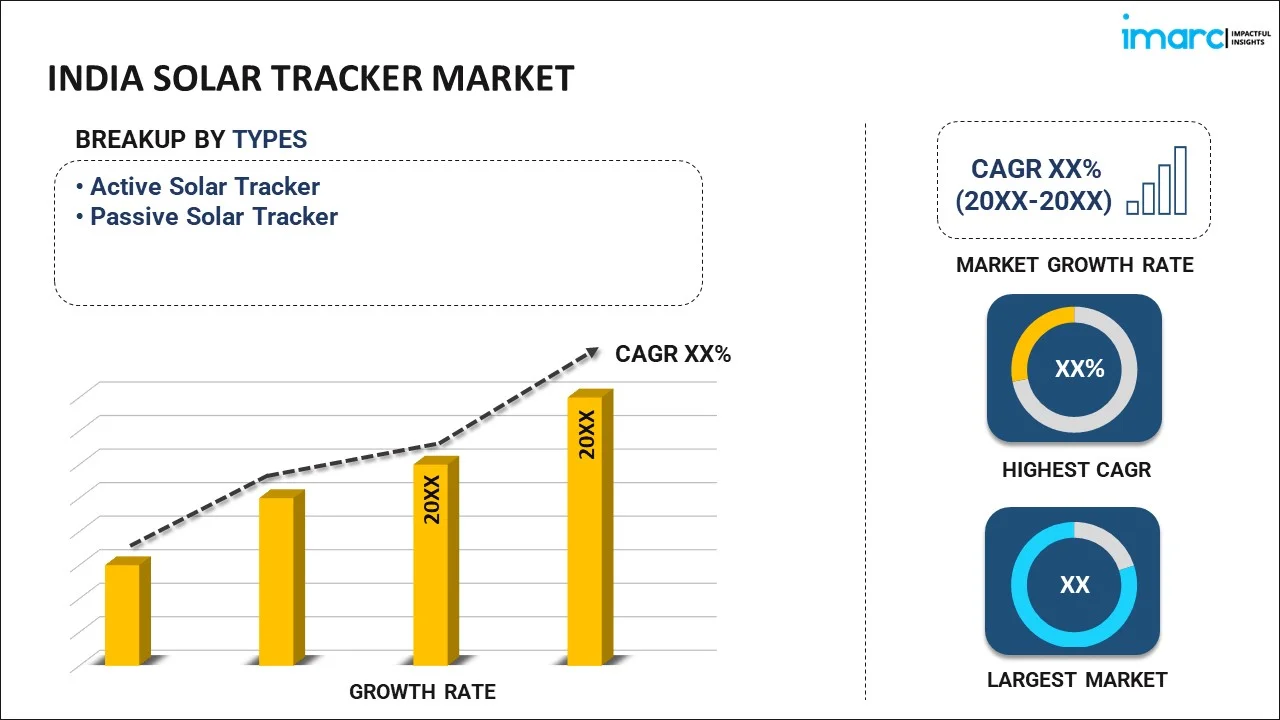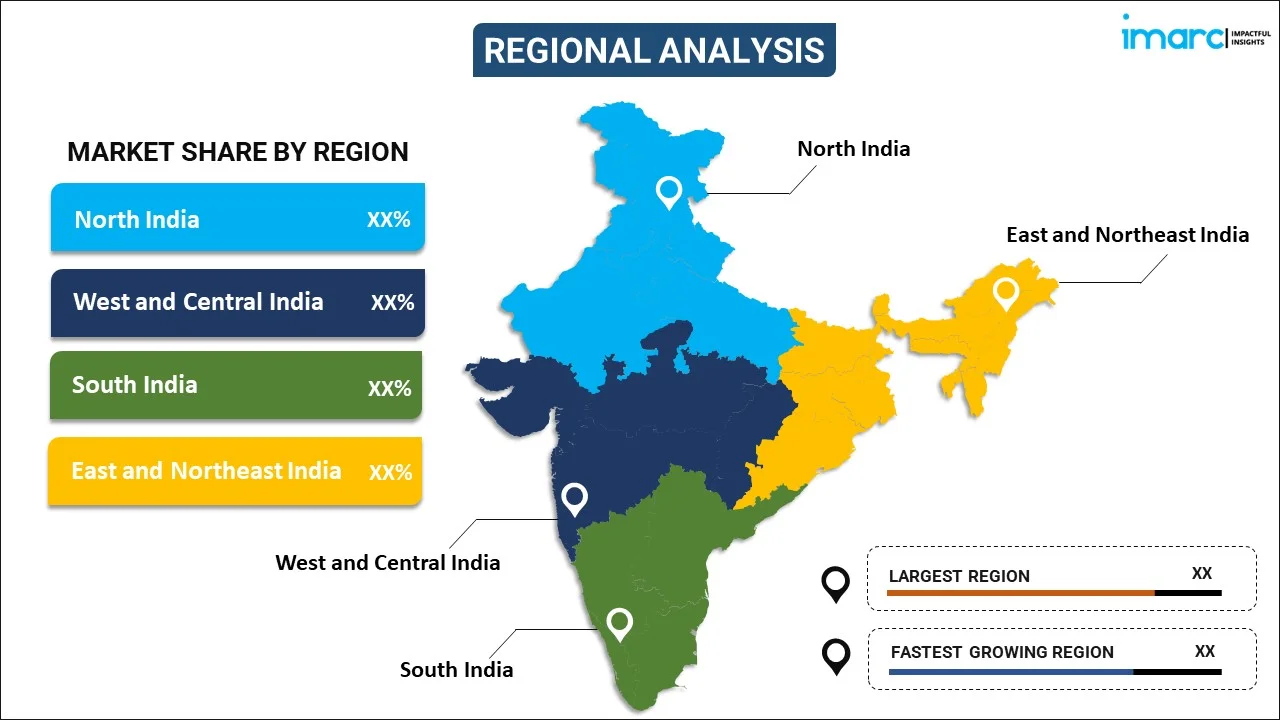
India Solar Tracker Market Report by Type (Active Solar Tracker, Passive Solar Tracker), Tracking Type (Single Axis Tracking, Dual Axis Tracking), Technology (Solar Photovoltaic (PV), Concentrated Solar Power (CSP), Concentrated Photovoltaic (CPV)), Application (Utility Sector, Residential Sector, Commercial Sector), and Region 2025-2033
Market Overview:
India solar tracker market size is projected to exhibit a growth rate (CAGR) of 5.60% during 2025-2033. The increasing innovations in materials and control systems, which contribute to making solar trackers more efficient and cost-effective, are driving the market.
|
Report Attribute
|
Key Statistics
|
|---|---|
|
Base Year
|
2024 |
|
Forecast Years
|
2025-2033 |
|
Historical Years
|
2019-2024
|
| Market Growth Rate (2025-2033) | 5.60% |
A solar tracker is a device that automatically adjusts the orientation of solar panels or mirrors to optimize their alignment with the sun throughout the day. By continuously tracking the sun's movement, solar trackers enhance energy capture and increase the efficiency of solar power systems. There are two main types of solar trackers: single-axis and dual-axis. Single-axis trackers follow the sun's path on one plane, typically from east to west, while dual-axis trackers also account for the sun's changing elevation. This dynamic alignment ensures that solar panels receive maximum sunlight exposure, thereby boosting energy output. Solar trackers play a crucial role in maximizing the performance of solar installations, contributing to increased energy production and improved overall cost-effectiveness in solar power generation.
India Solar Tracker Market Trends:
The burgeoning solar tracker market in India is driven by several key factors, seamlessly intertwining to propel its unprecedented growth. To begin with, the escalating demand for renewable energy sources has catalyzed the adoption of solar power solutions. As governments in India prioritize sustainable initiatives and commit to reducing carbon footprints, solar trackers emerge as pivotal components, optimizing energy production and enhancing the overall efficiency of solar installations. Furthermore, advancements in technology play a pivotal role in steering the solar tracker market forward. The integration of sophisticated tracking systems, leveraging sensors and automation, has exponentially increased the efficacy of solar farms. Consequently, investors and stakeholders are drawn to the prospect of maximizing energy output while minimizing operational costs, reinforcing the market's upward trajectory. Simultaneously, the decreasing costs of solar technology components contribute significantly to the market's expansion. The affordability of solar trackers has made them more accessible to a broader spectrum of consumers, fostering widespread adoption across residential, commercial, and industrial sectors. This intersection of environmental consciousness, technological innovation, and cost-effectiveness propels the solar tracker market in India, positioning it at the forefront of the renewable energy revolution.
India Solar Tracker Market Segmentation:
IMARC Group provides an analysis of the key trends in each segment of the market, along with forecasts at the country level for 2025-2033. Our report has categorized the market based on type, tracking type, technology, and application.
Type Insights:

- Active Solar Tracker
- Passive Solar Tracker
The report has provided a detailed breakup and analysis of the market based on the type. This includes active solar tracker and passive solar tracker.
Tracking Type Insights:
- Single Axis Tracking
- HSAT (Horizontal Single Axis Trackers)
- VSAT (Vertical Single Axis Trackers)
- TSAT (Titled Single Axis Trackers)
- PSAT (Polar Aligned Single Axis Trackers)
- Dual Axis Tracking
- TTDAT (Tip-Tilt Dual Axis Trackers)
- AADAT (Azimuth-Altitude Dual Axis Trackers)
A detailed breakup and analysis of the market based on the tracking type have also been provided in the report. This includes single axis tracking [HSAT (horizontal single axis trackers), VSAT (vertical single axis trackers), TSAT (titled single axis trackers) and PSAT (polar aligned single axis trackers) and dual axis tracking [TTDAT (tip-tilt dual axis trackers) and AADAT (azimuth-altitude dual axis trackers).
Technology Insights:
- Solar Photovoltaic (PV)
- Concentrated Solar Power (CSP)
- Concentrated Photovoltaic (CPV)
The report has provided a detailed breakup and analysis of the market based on the technology. This includes solar photovoltaic (PV), concentrated solar power (CSP), and concentrated photovoltaic (CPV).
Application Insights:
- Utility Sector
- Residential Sector
- Commercial Sector
A detailed breakup and analysis of the market based on the application have also been provided in the report. This includes utility sector, residential sector, and commercial sector.
Regional Insights:

- North India
- West and Central India
- South India
- East and Northeast India
The report has also provided a comprehensive analysis of all the major regional markets, which include North India, West and Central India, South India, and East and Northeast India.
Competitive Landscape:
The market research report has also provided a comprehensive analysis of the competitive landscape. Competitive analysis such as market structure, key player positioning, top winning strategies, competitive dashboard, and company evaluation quadrant has been covered in the report. Also, detailed profiles of all major companies have been provided.
India Solar Tracker Market Report Coverage:
| Report Features | Details |
|---|---|
| Base Year of the Analysis | 2024 |
| Historical Period | 2019-2024 |
| Forecast Period | 2025-2033 |
| Units | US$ Million |
| Scope of the Report | Exploration of Historical Trends and Market Outlook, Industry Catalysts and Challenges, Segment-Wise Historical and Future Market Assessment:
|
| Types Covered | Active Solar Tracker, Passive Solar Tracker |
| Tracking Types Covered |
|
| Technologies Covered | Solar Photovoltaic (PV), Concentrated Solar Power (CSP), Concentrated Photovoltaic (CPV) |
| Applications Covered | Utility Sector, Residential Sector, Commercial Sector |
| Regions Covered | North India, West and Central India, South India, East and Northeast India |
| Customization Scope | 10% Free Customization |
| Report Price and Purchase Option | Single User License: US$ 2699 Five User License: US$ 3699 Corporate License: US$ 4699 |
| Post-Sale Analyst Support | 10-12 Weeks |
| Delivery Format | PDF and Excel through Email (We can also provide the editable version of the report in PPT/Word format on special request) |
Key Questions Answered in This Report:
- How has the India solar tracker market performed so far and how will it perform in the coming years?
- What has been the impact of COVID-19 on the India solar tracker market?
- What is the breakup of the India solar tracker market on the basis of type?
- What is the breakup of the India solar tracker market on the basis of tracking type?
- What is the breakup of the India solar tracker market on the basis of technology?
- What is the breakup of the India solar tracker market on the basis of application?
- What are the various stages in the value chain of the India solar tracker market?
- What are the key driving factors and challenges in the India solar tracker?
- What is the structure of the India solar tracker market and who are the key players?
- What is the degree of competition in the India solar tracker market?
Key Benefits for Stakeholders:
- IMARC’s industry report offers a comprehensive quantitative analysis of various market segments, historical and current market trends, market forecasts, and dynamics of the India solar tracker market from 2019-2033.
- The research report provides the latest information on the market drivers, challenges, and opportunities in the India solar tracker market.
- Porter's five forces analysis assist stakeholders in assessing the impact of new entrants, competitive rivalry, supplier power, buyer power, and the threat of substitution. It helps stakeholders to analyze the level of competition within the India solar tracker industry and its attractiveness.
- Competitive landscape allows stakeholders to understand their competitive environment and provides an insight into the current positions of key players in the market.
Need more help?
- Speak to our experienced analysts for insights on the current market scenarios.
- Include additional segments and countries to customize the report as per your requirement.
- Gain an unparalleled competitive advantage in your domain by understanding how to utilize the report and positively impacting your operations and revenue.
- For further assistance, please connect with our analysts.
 Inquire Before Buying
Inquire Before Buying
 Speak to an Analyst
Speak to an Analyst
 Request Brochure
Request Brochure
 Request Customization
Request Customization




.webp)




.webp)












